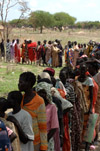
Sudan’s internally displaced population has topped 4.9 million, giving the east African country the unenviable distinction as having the largest displaced population in the world, according to a new report out this week.
The Internal Displacement Monitoring Centre (IDMC), which is part of the Norwegian Refugee Council, released its most recent figures for Sudan, along with an updated full country profile that describes the conditions that, over the years, have led to massive displacement in various regions. By way of comparison, Pakistan, the runner-up according to IDMC, has an estimated 2.1 million displaced people within its borders.
In particular, the IDMC report points to conflicts in the southern, eastern, and western regions as the main drivers of displacement in Sudan.
Sudan’s conflicts, in the south, the west and the east, have all been fuelled by a common cause: the political and economic marginalisation by the central government in Khartoum of Sudan’s peripheral regions, leading them to demand a more equal distribution of the country’s national wealth and greater political autonomy.
At the height of the conflict between the North and the South which officially ended with the signing of the 2005 Comprehensive Peace Agreement, an estimated four million IDPs and half a million refugees had been displaced by the fighting. Displacement from the civil war lingers, and the capital of Khartoum currently hosts an estimated 1.4 million people, mainly from the South, who are seeking greater economic opportunities. In southern Sudan, inter-communal violence, and raids by the notorious Lord’s Resistance Army have caused over 200,000 people to be newly displaced in 2008 and early 2009 alone.
Tension remains high in the ‘Three Areas’ (Abyei, Southern Kordofan and Blue Nile), leaving upwards of 360,000 people displaced in the volatile region by the end of 2008. The often overlooked conflict in Eastern Sudan, which stems from prior tensions with the government and discontent over the Eastern Sudan Peace Agreement, had generated as many as 420,000 displaced people in one of Sudan’s poorest regions.
Finally, the report findings indicate that ongoing violence in Darfur displaced an estimated 317,000 people in 2008, often for the second or third time since the conflict began in early 2003. By January 2009, 2.7 million Darfuris were displaced, out of a total population of about 6 million.
The IDMC article comes at a crucial time during the campaign to end the ongoing violence in Darfur and recommit to the terms of the CPA. As these figures illustrate, the whole of Sudan continues to face the significant humanitarian challenges that accompany such a large number of IDPs. Therefore, concerted efforts on the part of the international community are needed to broker a sustainable peace and negotiate away the current barriers to international aid, on which Sudan’s displaced populations depend. The IDMC article is a stark reminder that there is still a great deal of work to do. As long as these numerous and often interconnected conflicts persist, Sudan’s record number of IDPs will only mount.

